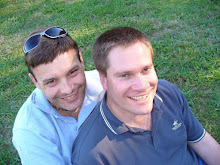I flew in on Friday just in time to join Matt and his friends for a fun-filled evening at the local Fishing Club. The club itself is a fairly nondescript venue. However, it offers unrivalled view of Pilot Bay and the Mount beyond.
On Saturday morning, Matt, Shelley and I visited my mother's grave and officially "unveiled" a new ceramic plaque memorializng my parents. The plaque looks amazing. It's turned out far better than anyone expected. The colours are well balanced and it's perfectly proportioned for its location. The manufacturer guarantees its colours won’t fade for a hundred years - not that we'll be around to challenge the warranty.
The plaque is a real family affair. Its background image was taken by Matt at the Fishing Club. Mum's image was taken from a professional photo shoot that Shelley won in a social media competition. I took Dad's image while visiting the Great Wall of China, while the final artwork was photoshopped and laid out by me.
As Shelley pointed out, the gravesite sits next to a set of stairs visitors use to access the cemetery. As a result, everyone will inevitably notice it as they grab the handrail. It's comforting to think that my parents will be remembered by all who visit the surrounding grounds.
Matt has also kept a small vial of Mum's ashes for him and Shelley to take to Japan. They plan to visit Miyajima and scatter Mum's ashes in the water where Mum and I scattered a vial of Dad's ashes more than a decade ago. I love the thought of them being united again in Japan, the country my father never ticked off his bucket list before he died.
After viewing the plaque, Matt, Shelly and I went for lunch at Umami Fusion Kitchen, a new Japanese restaurant. It's opened up in a mall where we once took Mum for coffee, or a meal, when she briefly lived at Copper Crest. It seemed a fitting tribute to her memory, neatly closing off another chapter in her life story.
Hamish and Karin are currently on holiday in Europe. As a result, we invited their daughters to join us for dinner on Sunday evening. It was a lovely evening. I enjoyed catching up with my nieces without their parents and enjoyed their company as young adults.
Monday was devoted to an outing I've thought about for years. During my time at university, I often spent my holidays on the Wallis farm in Raglan. Don Wallis was my roommate in the hostel in my first year at Waikato University. His parents became substitute parents for me when Mum and Dad relocated to Taihape, while his younger brother Shaun, became a close friend and trusted confidant.
When I graduated from university in 1989, I spent a year on the farm milking cows twice daily until Shaun completed his tertiary studies later that year. The farm is set in a stunning location. It encompasses a peninsula in the Raglan Harbour, with the cowshed situated on a hill overlooking the surrounding area. I have many happy memories of my time there.
I moved off the farm in early 1990, then shortly after departed for Australia to undertake some extra study. I've never been back. In the years since I've wanted to return, see Shaun, meet his family and thank him for his friendship during my formative years. I also wanted to talk to him about my sexuality. He’s literally the last person from my youth whom I’ve never formally come out to.
On Monday, I drove 2.5 hours across the North Island to reunite with Shaun. I stopped in Hamilton briefly to wander the grounds at Waikato University and took a side trip into Raglan to see how it’s evolved, before finally making my way to the farm in Okete. Shaun and I spent three hours catching up on thirty years of history. It was a wonderful reunion and a truly cathartic experience. For me, it closed off another chapter in my life.
I flew home again on Tuesday morning. I'm unsure when I'll return to New Zealand. For more than thirty years my parents have been the primary catalyst for almost every visit I've ever made. It's somewhat disconcerting to realise that the fundamental driver for these excursions has gone. However, this latest trip reminded me how much I enjoy Matt and Shelley's company and how much I value their friendship. Another cathartic moment indeed.
























































